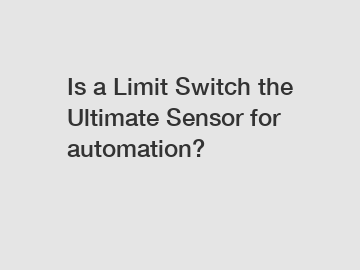Is a Limit Switch the Ultimate Sensor for automation?
Is a Limit Switch the Ultimate Sensor for automation?
Automation has revolutionized the manufacturing industry, and sensors play a crucial role in this domain. Among the numerous sensors available, the limit switch is often regarded as a fundamental component for automation systems. A limit switch is a device that detects the physical presence or absence of an object and is commonly used to control the movement and position of various machinery. But is a limit switch truly the ultimate sensor for automation? Let's delve deeper into this topic and explore its various aspects.
1. Functionality and Reliability:

A limit switch is designed to provide a simple yet effective solution for automation. It operates based on mechanical contact, which ensures direct and accurate detection, making it highly reliable in industrial settings. With their robust construction, limit switches can withstand harsh environments, including extreme temperatures, vibrations, and dust. Moreover, they offer a long lifespan, reducing the need for frequent replacements, which is beneficial for cost-saving and minimizing downtime in automated systems.
2. Versatility and Adaptability:
Limit switches are available in various types, such as lever, plunger, and roller lever, offering flexibility and versatility in their applications. They can be easily integrated into different automated systems, including conveyor belts, doors, lifts, and robotic arms. The adaptability of limit switches allows them to function effectively in diverse industrial sectors, such as automotive, packaging, and food processing. By utilizing appropriate actuators, limit switches can be configured to suit specific needs, making them an adaptable choice.
3. Precise Positioning:
Position control is a critical aspect of automation, and limit switches excel in providing precise positioning. They allow for accurate detection of the end point or limit of a particular motion, ensuring proper alignment and preventing excess movement. This feature is particularly valuable in repetitive tasks, where consistency in positioning is necessary. Limit switches enable automation systems to achieve high levels of accuracy, contributing to the overall efficiency and quality of production processes.
4. Limitations and Alternatives:
While limit switches have numerous advantages, it is essential to consider their limitations and potential alternatives. Firstly, their mechanical design presents a risk of wear and tear over time, leading to reduced reliability. Additionally, limit switches may not be suitable for applications that require non-contact sensing or when dealing with extremely small objects. In such cases, alternatives like proximity sensors or vision systems might be more appropriate.
5. Sensor Integration:
Automation systems often utilize multiple sensors to enhance their functionality and overall performance. It is crucial to consider the integration of various sensors, including limit switches, to achieve optimal automation efficiency. By combining different sensors, such as proximity sensors for non-contact detection and limit switches for end-point positioning, a comprehensive and robust automation system can be created. This integration allows for greater flexibility and the ability to adapt to different manufacturing requirements.
6. Evolving Sensor Technologies:
As technology progresses, new sensor technologies continue to emerge, and advancements are being made in existing ones. While limit switches have proven their reliability and effectiveness over the years, it is worth exploring new possibilities. For example, the integration of IoT (Internet of Things) and AI (Artificial Intelligence) in automation systems opens up opportunities for advanced sensor solutions, such as smart sensors and machine vision systems. These technologies offer a higher level of automation, enabling predictive maintenance and real-time monitoring, leading to increased productivity and minimized downtime.
In conclusion, while a limit switch is undoubtedly a crucial sensor in automation systems, claiming it to be the ultimate sensor would neglect the importance of considering different factors and requirements. Limit switches provide reliable operation, versatility, and precise positioning, making them a popular choice in manufacturing industries. However, their limitations must be acknowledged, and the integration of complementary sensors should be considered for optimal automation efficiency. As technology advances, it is vital to stay up-to-date with evolving sensor technologies that can further enhance automation systems and drive future advancements in the industry. So, is a limit switch the ultimate sensor for automation? Perhaps not, but it certainly remains a valuable tool in the vast toolkit of automation.
Want more information on Waterproof Limit Switch, Roller Lever Actuator Limit Switch, Parallel Top-roller Plunger Limit Switch? Feel free to contact us.

Comments
0